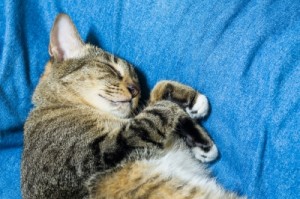Cats: Top 8 Tips to Lose Weight
Why are these top 8 tips to lose weight so important?
As a byproduct of our modern lifestyle, with more calorie intakes and less activity, many cats developed the same bad habits as their owners. There is no more need for an adopted cat to hunt and consequently not much action. They copied the human’s lifestyle – they eat, not only when are hungry, but also for comforting themselves under the stress. The only thing which is missing, comparing with the men’s lifestyle, is watching TV; but, napping is a must. As a result, today we have more than 50% overweight and obese cats, only in the U.S., according to one scientific study.
Obesity in cats leads to development of many ailments, such as diabetes, arthritis, hepatic lipidosis, skin problems, heart disease, bladder stone, etc. According to vets, the cat considered too overweight when the body fat is above 20%. We can find out easy whether our cat is overweight if we look at her body from above and pay attention to her waist. If we can see her waist then we do not have to worry. Another method is to put our palms around her abdomen and if we can feel the ribs – that is fine. In any other case, we have to follow these top 8 tips, recommended by a team of vets from Pet360, Inc. These 8 practical tips help us to do as much as we can for our loving pets, their health and length of life.
Top 8 Tips to Lose Weight:
To get a cat to lose weight, do the following after consulting with your veterinarian:
1. Have a thorough physical exam, lab tests, and accurate weigh recorded. Be sure to rule out hypothyroidism or other metabolic disorders.
2. Feed less food than you have been
3. Feed foods high in protein and fat and low in carbohydrate
4. Feed small portions at intervals (2x to 4x per day) rather than continuous free access/ free choice
5. Increase the cat’s activity/exercise by enriching the cat’s environment.
6. Reweigh the cat at three to four week intervals to assess your weight loss diet’s progress
7. Reconsider the total daily amount fed if weight gain or no weight loss is noted
8. Once the cat is at an idea weight, adjust the total amount fed so that the cat’s body weight remains stable.
As we can see, an accent is on feeding, because the most common cause for obesity is that the cat eats more than she could spend through her activities. If we eliminated the presence of some metabolic disorder, then we have to put our cat on a diet and help her exercise. Any habit needs a long time to develop, and accordingly, we have to prepare ourselves that changing habits is not an easy job, neither for us nor for our pet. However, with patience, persistence and love we have for our little friends, we can manage to change the bad habits, establish the new one and help the cat to stay in a good shape, vital and happy.
If you find these tips usefull and want to share with others, click on the one of the following buttons:










